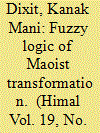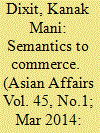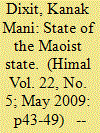| Srl | Item |
| 1 |
ID:
102052


|
|
|
| 2 |
ID:
072733


|
|
|
| 3 |
ID:
084831


|
|
|
|
|
| Publication |
2008.
|
| Summary/Abstract |
Oldfield served as the doctor at the British Residency in Kathmandu from 1850 to 1863, during the early years of the reign of Jang Bahadur Rana. Most previous Nepali art was religious art, but Oldfield's water-colours are of secular subjects and as such provide important information on the architecture of the Kathmandu valley at that time. His work was so accurate that it has helped to guide some recent restoration projects. The article is illustrated by ten of his pictures, eight in colour. They include two pictures of Jang Bahadur's army closing on Kyaurung , on the Tibetan border
|
|
|
|
|
|
|
|
|
|
|
|
|
|
|
|
| 4 |
ID:
086743


|
|
|
|
|
| Publication |
2009.
|
| Summary/Abstract |
Even with the end of the LTTE as a pseudo state power, it is clear that without power-sharing and the recognition of the rights of all communities, the authoritarian regime of Mahinda Rajapakse will only further alienate Sri Lanka's minorities.
|
|
|
|
|
|
|
|
|
|
|
|
|
|
|
|
| 5 |
ID:
095771


|
|
|
| 6 |
ID:
140053


|
|
|
| 7 |
ID:
066819


|
|
|
| 8 |
ID:
128029


|
|
|
|
|
| Publication |
2014.
|
| Summary/Abstract |
With Partition and the rise of various different nationalisms there came the need to find a new name for what used to be called "British India". A framework for co-operation between the new countries was also needed. Initially regionalism was fashionable. But the regional organisation, SAARC, embodied cooperation between all the nation-states of the region, a veritable lowest common denominator rather than an additional layer of an inclusive regional identity for all the citizenry. The increasing use of "Southasia" is based on a recognition that even though India looms large, the region contains other countries with sizeable populations in a global context. But flesh must be put on the bones of the concept. The key is sub-regional commercial cooperation between viable units. There are many opportunities for cross-border economic activity, but what is needed is a porous border like the India/Nepal border, not a militarised border like the India /Pakistan border. Connectivity and bilateral free trade agreements will bring results and the Indian state of Punjab and the Pakistani province of Punjab are perhaps best placed to give an example of cooperation.
|
|
|
|
|
|
|
|
|
|
|
|
|
|
|
|
| 9 |
ID:
072820


|
|
|
| 10 |
ID:
088320


|
|
|
|
|
| Publication |
2009.
|
| Summary/Abstract |
Nine months after the Communist Party of Nepal (Maoist) took charge of the government following success in the elections to the Constituent Assembly, the national condition in Nepal today is characterised by a series of absences: of rule of law, of government, of development, of reconstruction and rehabilitation, of investment and economic revival. The elections of April 2008 threw up a Maoist party that had yet to be socialised into open society, while the leadership began projecting the election win as an endorsement of the decade-long 'people's war'.
The public pins its hope on the constitution-writing, but the work has barely begun halfway to the stipulated deadline, because the newly renamed United Communist Party of Nepal (Maoist) is unable or unwilling to lead the process. Meanwhile, the peace process itself is threatened by the Maoists' sudden reluctance to abide by previous understandings on integration and rehabilitation of their combatants, themselves verified at more than double their conflict-period estimated numbers
|
|
|
|
|
|
|
|
|
|
|
|
|
|
|
|
| 11 |
ID:
072740


|
|
|